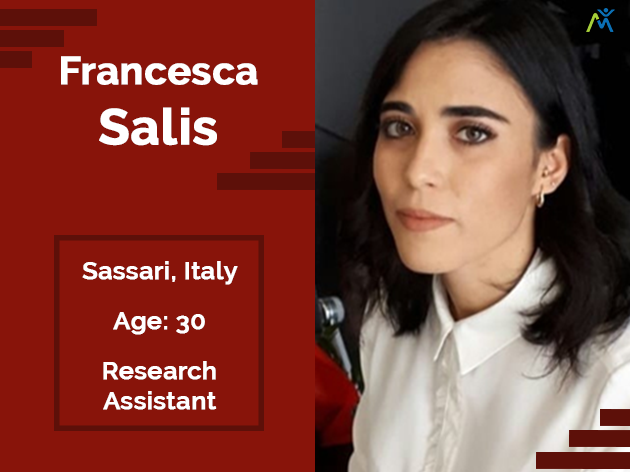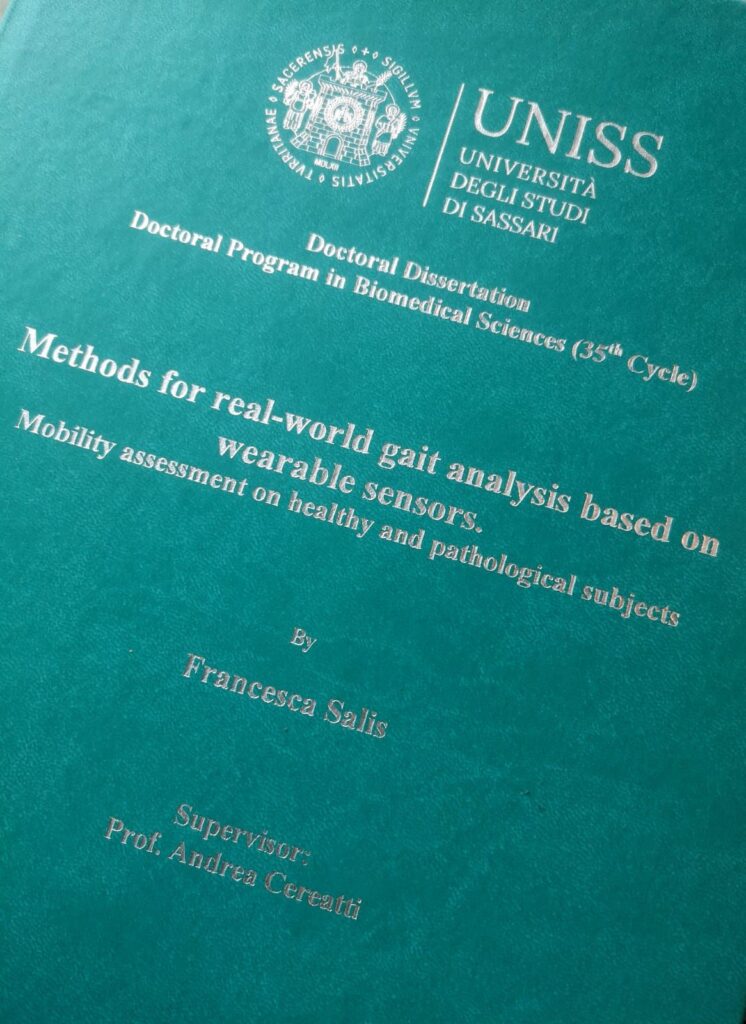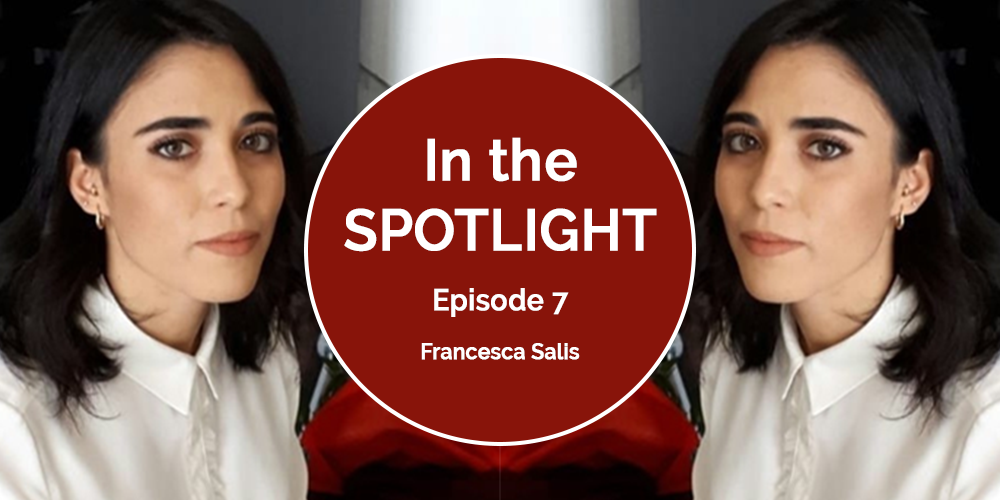In this Spotlight episode, we delve deeper into the life and career of Francesca Salis, a 30-year-old biomedical engineer and fresh Ph.D. with a passion for real-world motion analysis solutions. Originally from Sassari, Sardinia, Francesca has made Turin her home for over a decade, and her journey unfolds against the backdrop of a rich tapestry of experiences. Passionate about Lindy Hop, sports and family, Francesca shares not only her professional trajectory but also the personal motivations that propelled her into the world of research. From working in a research group during her master’s thesis to the profound impact of her cousin’s multiple sclerosis diagnosis, Francesca discusses the crucial moments that shaped her commitment to making tangible contributions to healthcare advancements. In this Spotlight episode, Francesca reflects on her academic career, her role in the Mobilise-D Consortium, and the diverse activities that keep her both physically active and creatively energized.
1. Can you tell us a bit about yourself?
My name is Francesca, and I’m 30 years old. Originally from Sassari, Sardinia, I’ve been calling Turin home for the past 11 years. Professionally, I hold a degree in Biomedical Engineering and a Ph.D. in Biomedical Sciences, specializing in real-world motion analysis solutions.
Outside of work, I’m passionate about Lindy Hop and sports. In my earlier years, I was into track and field until the age of 20, and later transitioned to the gym and Pilates. I find joy in capturing moments through photography.
Family is a cornerstone for me. I am an only child, closely connected with my parents who made the courageous move to join me in Turin after I initially ventured here on my own. I come from a large family with numerous aunts, uncles, and cousins – my mother has eight siblings!
On a lighter note, a fun fact about me is that I was once suggested to become a Latin scholar by my Latin teacher in high school. Despite my love for all subjects, I eventually chose the path of engineering. However, who knows what the future holds – a degree in ancient literature might still be on the horizon.
2. Why did you choose, or how did you end up, in research?

Essentially, there are two main reasons why I chose to pursue research. Firstly, during my master’s thesis, I had my first experience in a research group, and I found it immensely rewarding. I enjoy the idea of making a tangible contribution to improving the lives of others.
Secondly, on a more personal note, during the same year, my cousin, at the age of 28, was diagnosed with multiple sclerosis. This gave me additional motivation to delve into clinical research and embark on this path. The desire to contribute to meaningful advancements in healthcare became even more profound with a real-life connection to the impact of medical conditions.
3. Can you tell us a bit about your academic career?
My academic journey has been both challenging and rewarding. I completed my undergraduate studies in Biomedical Engineering at Politecnico di Torino in 2018. Following that, I delved into the world of research as a research fellow at the University of Sassari, where I worked on developing algorithms for estimating spatio-temporal parameters of gait.
In 2019, I embarked on a Ph.D. in Biomedical Sciences at the University of Sassari, and successfully defended my thesis in October 2023. The entire Ph.D. was funded by the European project Mobilise-D, with a primary focus on developing solutions to analyze movement in real-life conditions using multi-sensor approaches. After my Ph.D., I gained further research experience as a Research Assistant at Politecnico di Torino.
Throughout my academic career, I’ve accumulated expertise in algorithm development, data analysis, and the management of large datasets. I’ve actively participated in and conducted clinical experiments, showcasing my proficiency in wearable technologies and less conventional methods for quantitative analyses in the rehabilitation domain. Additionally, I’ve supervised experimental theses, primarily focused on clinical applications involving wearable devices and traditional or machine learning algorithms.
My research interests lie at the intersection of clinical and engineering realms, and I am eager to contribute to the digital health field by applying my skills and knowledge.


4. What’s your role in the Mobilise-D Consortium?
I was part of the WP2 team responsible for technical validation. Specifically, the Sassari team aimed to provide a wearable gold standard (INDIP) for real-world validation of single sensors. My role involved developing algorithms for gait parameter extraction from INDIP data and analyzing them to assess system performance.
During the project, I was actively testing the INDIP with sensors strapped on, even amidst strict Covid regulations in Italy. I vividly remember going out specifically to test INDIP, and I lost track of how much I walked! Despite the challenges, I successfully achieved our goal, leading to the publication of several scientific contributions. A memorable aspect was presenting my work at various conferences and meetings, including one in Keystone, Colorado — my first time in America!
5. What do you do to keep yourself Mobilised?
To stay mobilized, I engage in a variety of activities that not only keep me physically active but also bring joy to my routine. I’m an avid Lindy Hop dancer, finding the rhythm and movement a fantastic way to stay energized and maintain flexibility. Additionally, I frequent the gym and participate in Pilates sessions, to improve my strength. Beyond structured workouts, I also enjoy long walks, finding them not only refreshing but a great way to clear my mind. This combination of activities helps me maintain a balanced and active lifestyle.
Francesca Salis’s commitment to advancing real-world motion analysis in healthcare is evident through her impactful research contributions. For an in-depth exploration of her work, you can explore the following publications:
A multi-sensor wearable system for the assessment of diseased gait in real-world conditions. Frontiers in Bioengineering and Biotechnology. 2023;11.
Performance of a multi-sensor wearable system for validating gait assessment: preliminary results on patients and healthy. Gait & Posture. 2022 Oct 1;97:13.
A method for gait events detection based on low spatial resolution pressure insoles data. Journal of Biomechanics. 2021 Oct 11;127:110687.
A wearable multi-sensor system for real world gait analysis. In: 2021 43rd Annual International Conference of the IEEE Engineering in Medicine & Biology Society (EMBC). 2021.
Accuracy of a multi-sensor system in stride parameters estimation: comparison of straight and curvilinear portions. Proceedings XXI Congresso SIAMOC 2021. Bologna; p. 95; 2021.
Multi-sensor integration and data fusion for enhancing gait assessment In and Out of the laboratory. Gait & Posture, 74; 2019 Sep 30; Bologna, Italy.
Remember to FOLLOW us on Facebook, Twitter and LinkedIn.
Subscribe to our Newsletter.






